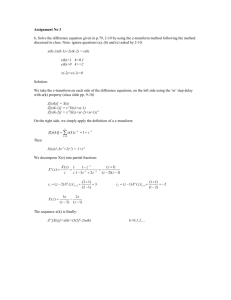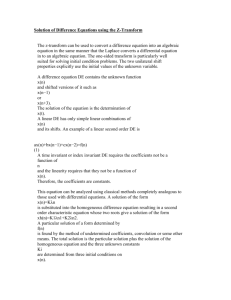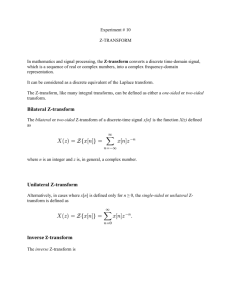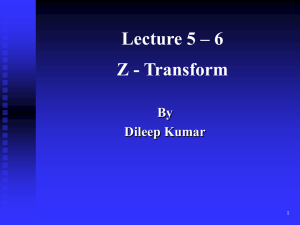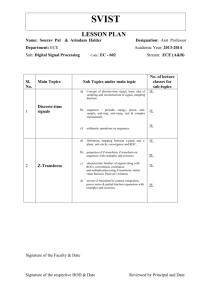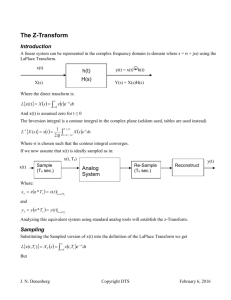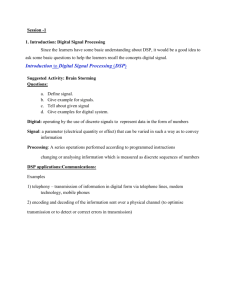DSP-EEE-UNIT
advertisement
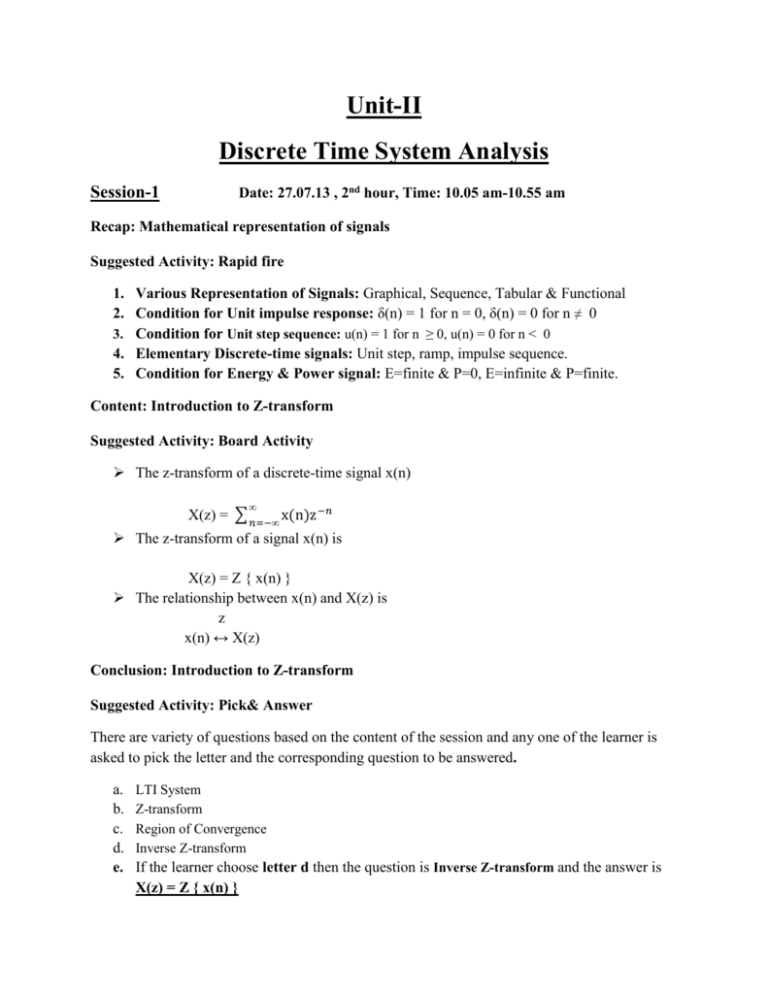
Unit-II
Discrete Time System Analysis
Session-1
Date: 27.07.13 , 2nd hour, Time: 10.05 am-10.55 am
Recap: Mathematical representation of signals
Suggested Activity: Rapid fire
1. Various Representation of Signals: Graphical, Sequence, Tabular & Functional
2. Condition for Unit impulse response: δ(n) = 1 for n = 0, δ(n) = 0 for n ≠ 0
3. Condition for Unit step sequence: u(n) = 1 for n ≥ 0, u(n) = 0 for n < 0
4. Elementary Discrete-time signals: Unit step, ramp, impulse sequence.
5. Condition for Energy & Power signal: E=finite & P=0, E=infinite & P=finite.
Content: Introduction to Z-transform
Suggested Activity: Board Activity
The z-transform of a discrete-time signal x(n)
∞
X(z) = ∑𝑛=−∞ x(n)z −𝑛
The z-transform of a signal x(n) is
X(z) = Z { x(n) }
The relationship between x(n) and X(z) is
z
x(n) ↔ X(z)
Conclusion: Introduction to Z-transform
Suggested Activity: Pick& Answer
There are variety of questions based on the content of the session and any one of the learner is
asked to pick the letter and the corresponding question to be answered.
a.
b.
c.
d.
e.
LTI System
Z-transform
Region of Convergence
Inverse Z-transform
If the learner choose letter d then the question is Inverse Z-transform and the answer is
X(z) = Z { x(n) }
Ref : http://en.wikibooks.org/wiki/Digital_Signal_Processing/Z_Transform
Session-2
Date: 30.07.13 , 5th hour, Time: 01.30 pm-02.20 pm
Recap: Introduction to Z-transform
Suggested Activity: Quiz
1. z-transform is
∞
X(z) = ∑𝒏=−∞ 𝐱(𝐧)𝐳 −𝒏
2. Region of Convergence means X(z) attains a finite value.
3. Zk becomes unbounded for Z = ∞
4. Z-k becomes unbounded for Z = 0
Content: Z-transform and its properties
Suggested Activity: Match the following
Column-A
Column-B
1. Linearity
d X(z) / dz
5
2. Time shifting
X(a-1z)
3
3. Scaling
a1X1(z)+a2X2(z)
1
4. Time reversal
z-kX(z)
2
5. Differentiation
X(z-1)
4
Ref : http://inst.eecs.berkeley.edu/~ee123/fa12/Notes/Lecture04.pdf-properties
Conclusion: Z-transform and its properties
Suggested Activity: Brainstorming
1.
2.
3.
4.
5.
Linearity : x(n) = a1x1(n)+a2x2(n) ↔ X(z) = a1X1(z) + a2X2(z)
Time shifting : x(n-k) ↔ z-k X(z)
Scaling : anx(n) ↔ X(a-1z)
Time reversal : x(-n) ↔ X(z-1)
Differentiation : nx(n) ↔ -z dX(z) / dz
Ref : http://math.fullerton.edu/mathews/c2003/ZTransformIntroMod.html
Session-3
Date: 31.07.13 , 3rd hour, Time: 11.10 am-12.00 pm
Recap: Z-transform and its properties
Suggested Activity: Questions & Answers
1. State the convolution of two sequences.
x(n) = x1(n)* x2(n) ↔ X(z) = X1(z)X2(z)
2. Define multiplication of two sequences.
x(n) = x1(n)x2(n)↔ X(Z) = 1 / 2π ∫c X1(v) X2(z/v) v-1 dv
3. Define the property of linearity.
x(n) = a1x1(n)+a2x2(n) ↔ X(z) = a1X1(z)+a2X2(z)
4. Define the property of time shifting.
x(n-k) ↔ z-k X(z)
5. Define the property of Scaling in z-domain.
anx(n) ↔ X(a-1z)
Content: Inverse z-transform
Suggested Activity: Group Activity
The entire class is divided into totally four groups. Each group is assigned a specific topic and
asked to discuss about various points involved in that topic.
Group-1:
The first group is asked to discuss about the long division method and the students
involved with more interest and also the steps involved is discussed.
.
Group-2:
The second group is asked to discuss about the partial fraction expansion method and the
students involved with more interest and also the steps involved is discussed.
Group-3:
The third group is asked to discuss about the residue method and the students involved
with more interest and also the steps involved is discussed.
Group-4:
The fourth group is asked to discuss about the convolution method and the students
involved with more interest and also the steps involved is discussed.
Conclusion: Inverse z-transform
Suggested Activity: Show & Tell Activity
X(z) = 1 / (1-1.5z-1+0.5z-2) -------------→ Long Division method
X(z) = (1+z-1) / (1-z-1+0.5z-2) --------------→ Partial Fraction Expansion method
X(z) = (1+z-1+z-2) / (1-z-1)
--------------→ Residue method
Ref : http://www.d-filter.ece.uvic.ca/SupMaterials/Slides/DSP-Ch03-S8.pdf
Session-4
Date: 31.07.13 , 4th hour, Time: 12.00 pm-12.50 pm
Recap: Inverse z-transform
Suggested Activity: Quiz
1. Define inverse z-transform.
−𝑛
X(z) = ∑∞
𝑛=−∞ 𝑐𝑛 z
2. List the different forms inverse z-transform.
a. Long Division method
b. Partial Fraction Expansion method
c. Residue method
d. Convolution method
3. Give another name for long division method.
Power Series Expansion
Content: Difference equation & Solution by Z-transform
Suggested Activity: Board Activity
Conclusion: Difference equation & Solution by Z-transform
Suggested Activity: Remembering
Ref: http://www.wolframalpha.com/input/?i=inverse+Z+transform+calculator
Session-5
Date: 02.08.13, 1st hour, Time: 09.15 am-10.05 am
Recap: Difference equation & Solution by Z-transform
Suggested Activity: Brain Storming
1. Trial solution method :
2. z-transform method :
3. Residue method :
Content: Application to discrete systems
Suggested Activity: Match the following
Column-A
1.
Column-B
Real part
(4)
2. Imaginary part
(3)
3. Convolution
(2)
4. Parseval's relation
(1)
Conclusion: Application to discrete systems
Suggested Activity: Recall by Keywords
(i) If
has a simple pole at
, then the residue is
.
(ii) If
has a pole of order
at
, then the residue is
.
(iii)
If
has a pole of order
at
, then the residue is
.
Ref: http://lpsa.swarthmore.edu/ZXform/InvZXform/InvZXform.html
Session-6
Date: 03.08.13 , 6th hour, Time: 2.20 pm-3.10 pm
Recap: Application to discrete systems
Suggested Activity: Group Discussion
The entire class is divided into totally three groups. Each group is assigned a specific topic and
asked to discuss about various points involved in that topic.
Group-1: Common Impulse Responses
The first group is asked to discuss about the Common Impulse Responses.
Delta Function:
The simplest impulse response is nothing more that a delta function, an impulse on the
input produces an identical impulse on the output. This means that all signals are passed
through the system without change. Convolving any signal with a delta function results in
exactly the same signal Mathematically, this is written: x(n)*δ(n) =x(n).
Group-2: Commutative Property
The commutative property for convolution is expressed in mathematical form:
a[n] * b[n] = b[n] * a[n],
the order in which two signals are convolved makes no difference; the results are
identical. In any linear system, the input signal and the system's impulse response can be
exchanged without changing the output signal.
Group-3: Distributive Property
In equation form, the distributive property is written:
a[n]*b[n]+a[n]*c[n] = a[n] * (b[n] + c [n] )
The distributive property describes the operation of parallel systems with added
outputs. The distributive property allows this combination of systems to be replaced with
a single system, having an impulse response equal to the sum of the impulse responses of
the original systems.
Content: Stability analysis
Suggested Activity: Brainstorming
1. Stability
It can be shown that for any system with a transfer function H(z), all the poles of H(z)
must lie within the unit-circle on the z-plane for the system to be stable. Zeros of the
transfer function may lie inside or outside the circle.
2. Gain
Gain is the factor by which the output magnitude is different from the input magnitude. If
the input magnitude is the same as the output magnitude at a given frequency, the filter is
said to have "unity gain".
3. Application to signal processing
Digital signal processing often involves the design of finite impulse response (FIR)
filters. A simple 3-point FIR filter can be described as
.
Conclusion: Stability analysis
Suggested Activity: Question & Answers
1. Give the condition for the system to be stable.
∑∞
𝑛=−∞ ℎ(𝑛) < ∞
2. What is the equation for one sided transform?
−𝒏
𝑿+ (𝒛) ≡ ∑∞
𝒏=𝟎 𝒙(𝒏)𝒛
3. Define First Order Difference Equations.
The solution of difference equations is analogous to the solution of differential
equations.
Ref:" http://ocw.mit.edu/resources/res-6-008-digital-signal-processing-spring-2011/studymaterials/MITRES_6_008S11_lec06.pdf
Session-7
Date: 07.08.13 , 1st hour, Time: 9.00 am-10.05 am
Recap: Stability analysis
Suggested Activity: Group Activity
The entire class is divided into totally three groups. Each group is assigned a specific topic and
asked to discuss about various points involved in that topic.
Group-1: Causality
The first group is asked to discuss about the causality of the system, (i.e), a linear time –invariant
system is causal if and only if the ROC of the system function is the exterior of a circle of radius
r < , including the point z = .
Group-2: Stability
The second group is asked to discuss about the stability of the system, the necessary and
sufficient condition for a linear time –invariant system to be BIBO stable is
∞
∑ ℎ(𝑛) < ∞
𝑛=−∞
Group-3: One-sided z-Transform
The two sided z-transform requires the signals to be in the range - < n < . The one-sided ztransform can be used to solve difference equations with initial conditions.
∞
+ (𝒛)
𝑿
≡ ∑ 𝒙(𝒏)𝒛−𝒏
𝒏=𝟎
Content: Frequency response
Suggested Activity: Tit for Tat
(i)First order systems
The first order system contains only one pole and the z-transform is given by,
X(z) = 1/ (1-z-1), which contains a pole at z=1.
Therefore the output signal has the transform, Y(z) = H(z)X(z).
(ii)Second order systems
The second order difference equation is given by,
Y(n) = -a1 y(n-1) - a2 y(n-2) + b0 x(n)
The system function is
H(z) = Y(z)/X(z) = b0 / (1 + a1 z-1 + a2 z-1)
= b0z2 / (z2+ a1 z +a2)
(iii)Steady state and transient response
The natural response is also called as the transient response, and it has the form
𝑁
𝑦𝑛𝑟 (𝑛) = ∑ 𝐴𝑘 𝑝𝑘𝑛 𝑢(𝑛)
𝑘=1
pk, k-1,2,…..,N are the poles of the system
Ak are scale factors of the system.
The forced response of the system is also termed as the Steady state response, and it has the
form,
𝐿
𝑦𝑓𝑟 (𝑛) = ∑ 𝑄𝑘 𝑞𝑘𝑛 𝑢(𝑛)
𝑘=1
qk, k-1,2,…..,N are the poles of the forcing function
Qk are scale factors of the system.
Conclusion: Frequency response
Suggested Activity: Unspoken word
1. Natural Response: Transient response of the causal system.
2. Forced Response : Steady state response of the causal system.
3. Three different cases:
a. Real and distinct poles
b. Real and equal poles
c. Complex-conjugate poles
Ref:" http://ocw.mit.edu/resources/res-6-008-digital-signal-processing-spring-2011/studymaterials/MITRES_6_008S11_lec06.pdf
Session-8
Date: 07.08.13 , 3rd hour, Time: 11.10 am-12.00 pm
Recap: Frequency response
Suggested Activity: Quiz
1. Natural Response is also called as Transient response
2. Forced Response is also called as Steady state response
3. Pole-Zero cancellations- z-transform has a pole at the same location as a zero, the pole
is cancelled by a zero.
Content: Fourier transform of discrete sequence
Suggested Activity: Board Activity
The z-transform of the unit-step sequence
is
.
Discrete Fourier Transform:
The discrete time signal x(n) is converted into an equivalent frequency domain representation
X(). Such a frequency domain representation X() leads to the Discrete Fourier Transform
(DFT).
Conclusion: Fourier transform of discrete sequence
Suggested Activity: Question & Answers
1. Define DFT.
It is a powerful computational tool for performing frequency analysis of discrete-time
signals.
2. Give the equation for the cos function.
The z-transform of the sequence
is
.
Ref: http://en.wikibooks.org/wiki/Digital_Signal_Processing/Sampling_and_Reconstruction
Session-9
Date: 16.08.13 , 2nd hour, Time: 10.05 am-10.55 am
Recap: Fourier transform of discrete sequence
Suggested Activity: Remembering
1. Converting time domain to frequency domain is DFT.
2. It is used for analysis of discrete time signals.
3. It is an equivalent frequency domain specification.
Content: Discrete Fourier series
Suggested Activity: Board Activity
1. Discrete Linear Convolution
Discrete linear convolution is the operation performed by a discrete filter, say T, to
obtain an output y[n] , when an input x[n].
2. Discrete Cyclic Convolution
The cyclic convolution is an operation performed on two periodic sequences, say x~[n]
and h[n] , with the same fundamental period of length, say N . The result of the cyclic
convolution is a new periodic sequence or discrete signal, say y~[n] , with the same
fundamental period of lengthN . Thus, the cyclic convolution of x~[n] and h[n] is a new
sequence y~[n].
3. Time-Domain Cyclic Convolution Theorem
The discrete Fourier transform (DFT) of the cyclic convolution of two sequences, say
x[n] and h[n] , is equal to the product of the discrete Fourier transforms of the individual
sequences.
Conclusion: Discrete Fourier series
Suggested Activity: Jumbled words
1. Noitulovnoc cilcyc - Cyclic convolution
2. Morfsnart reiruof- Fourier transform
Ref: http://www.youtube.com/watch?v=G-J4FG2L_yc
Ref: http://www.songho.ca/dsp/signal/signals.html
Session-10
Date: 16.08.13 , 3rd hour, Time: 11.10 am-12.00 pm
Content: Tutorial based on Z-transform and its properties
Suggested Activity: Board Activity- Problem Solving
1. Z-transform
Session-11
∞
X(z) = ∑𝑛=−∞ x(n)z −𝑛
Date: 17.08.13 , 6th hour, Time: 2.20 am-3.10 pm
Content: Tutorial based on Inverse Z-transform
Suggested Activity: Board Activity- Problem Solving
1. Long Division method
2. Partial Fraction Expansion method
Session-12
Date: 21.08.13 , 3rd hour, Time: 11.10 am-12.00 pm
Content: Tutorial based on Inverse Z-transform
Suggested Activity: Board Activity- Problem Solving
3. Convolution method
4. Residue method
Session-13
Date: 21.08.13 , 4th hour, Time: 12.00 pm-12.50 pm
Content: Tutorial based on Inverse Z-transform
Suggested Activity: Board Activity- Problem Solving
1. Solution to differential equations.
Ref: http://www.wolframalpha.com/input/?i=inverse+Z+transform+calculator
Ref: http://ocw.mit.edu/resources/res-6-008-digital-signal-processing-spring-2011/studymaterials/MITRES_6_008S11_lec06.pdf

